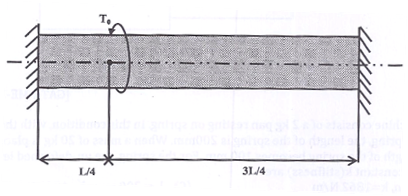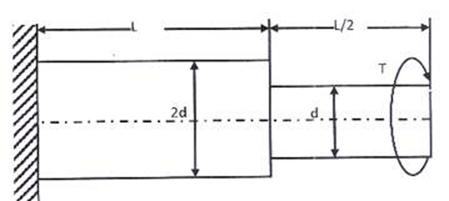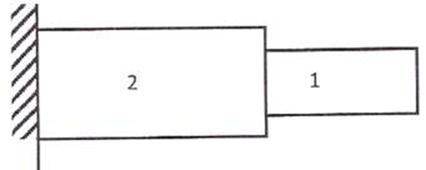Solved GATE Questions on Torsion
Question 1. Two helical tensile springs of the same material and also having identical mean coil diameter and weight, have wire diameters d and d/2. The ratio of their stiffness is
(A) 1
(B) 4
(C) 64
(D) 128
GATE-ME-2001
Hint 1. (Ans C)



Since wire weight is the same, therefore





Question 2. Maximum shear stress developed on the surface of a solid circular shaft under pure torsion is 240 MPa. If the shaft diameter is doubled then the maximum shear stress developed corresponding to the same torque will be
(A) 120 MPa
(B) 60 MPa
(C) 30 Mpa
(D) 15 Mpa
GATE-ME-2003
Hint 2. (Ans C)

When shaft diameter is doubled maximum shear stress 
Let d be the original diameter

….since Torque in both the cases is constant


Putting the values of Polar moment of inertia and radius



Question 3. A solid circular shaft of 60 mm diameter transmits a torque of 1600 N.m. The value of maximum shear stress developed is
(A) 37.72 MPa
(B) 47.72 MPa
(C) 57.72 MPa
(D) 67.72 MPa
GATE-ME-2004
Hint 3. (Ans A)

Question 4. A torque of 10 Nm is transmitted through a stepped shaft as shown in the figure. The torsional stiffness of individual sections of lengths MN, NO and OP are 20 Nm/rad, 30 Nm/ rad and 60 Nm/rad respectively. The angular deflection between the ends M and P of the shaft is

(A) 0.5 rad
(B) 1.0 rad
(C) 5.0 rad
(D) 10.0 rad
GATE-ME-2004
Hint 4. (Ans B)
Torque will be same on the part MN,NO, OP as they are connected in series





Question 5. A weighing machine consists of a 2 kg pan resisting on spring. In this condition, with the pan resting on the spring, the length of the spring is 200 mm. When a mass of 20 kg is placed on the pan, the length of the spring becomes 100 mm. For the spring, the un-deformed length and the spring constant k (stiffness) are
(A) I0=220 mm, k=1862 N/m
(B) I0=210 mm, k=1960 N/m
(C) I0=200 mm, k=1960 N/m
(D) I0=200 mm, k=2156 N/m
GATE –ME-2005
Hint 5. (Ans .B)
Let initial length is  without load, and stiffness is k
without load, and stiffness is k


Solving (i) and (ii), we get  =210 mm and k=1960 N/m
=210 mm and k=1960 N/m
Question 6. The two shafts AB and BC, of equal length and diameter d and d/2, are made of the same material they are joined at B through a shaft coupling, while the ends A and C are built in (cantilevered). A twisting moment T is applied to the coupling. If Ta and Tc represent twisting moments at the end A and C respectively, then
(A) Tc= Ta
(B) Tc= 8Ta
(C) Tc=16 Ta
(D)16 Tc= Ta
GATE-ME-2005
Hint 6. (Ans C )
Question 7. For a circular shaft of diameter d subjected to torque T, the maximum value of the shear stress is:
(A) 
(B) 32
(C) 16
(D) 8T/
GATE-ME-2006
Hint 7. (Ans C)
Let T =torque; d=diameter of the shaft and  =maximum value of shear stress,
=maximum value of shear stress,

Question 8. A compression spring is made of music wire of 2mm diameter having a shear strength and shear modulus of 800 MPa and 80 GPa respectively. The mean coil diameter is 20 mm, free length is 40 mm and the number of active coils is 10. If the mean coil diameter is reduced to 10 mm, the stiffness of the spring is approximately
(A)Decreased by 8 times
(B) Decreased by 2 times
(C) Increased by 2 times
(D) Increased by 8 times
GATE-ME-2008
Hint 8. (Ans D)

Here d1=d2=2 mm (diameter of spring wire)
G=80 GPa
D1=20, D2=10
n1=n2=10


Question 9. A solid shaft of diameter, d length and length L is fixed at both ends. Aa torque, T0 is applied at a distance L/4 from the left end as shown in the figure given below

The maximum shear stress in the shaft is
(A) 
(B)
(C)
(D) 4
GATE-ME-2009
Hint 9. (Ans B)



Question 10. A torque T is applied at the free end of a stepped rod of circular cross-section as shown in the figure. The shear modulus of the material of the rod is G. the expression of d to produce an angular twist  at the free end is
at the free end is

(A) 
(B) 
(C) 
(D) 
GATE-ME-2011
Hint 10. (Ans B)






Question 11. A solid circular shaft needs to be designed to transmit a torque of 50 Nm. If the allowable shear stress of the material is 140 MPa, assuming a factor of safety of 2, the minimum allowable design diameter in mm is
(A) 8
(B) 16
(C) 24
(D) 32
GATE-ME-2012
Hint 11. (Ans. B)



Answer keys
1. (C) 2. (C) 3. (A) 4. (B) 5. (B) 6. (C) 7. (C) 8. (D) 9. (B) 10.(B) 11. (B)